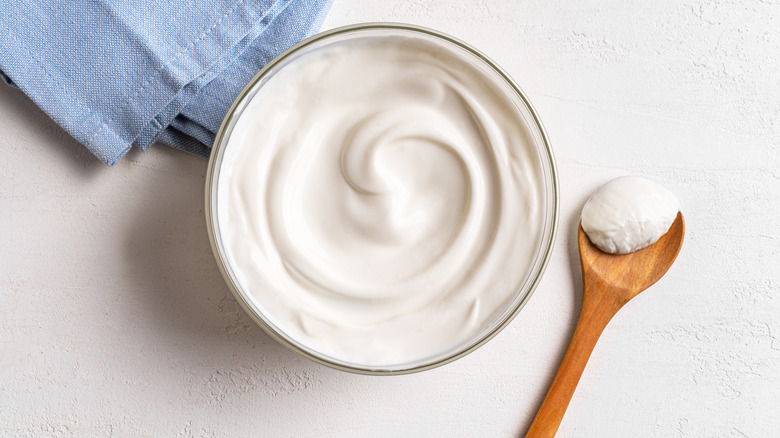The Ancient Mistake That Accidentally Created Yogurt
In English, it's called yogurt, yoghurt, and yoghourt. Russians like kefir, a thin, drinkable version, while Icelanders prefer skyr, so thick it barely moves from the spoon. In India, some take their lassi sweet, and some prefer salted. Some will argue its origins are Turkish, Bulgarian, African, or from what is now the Middle East. It was discovered anywhere from 3,000 to 10,000 years ago. A more diplomatic theory is that it was created in several places simultaneously. The one thing food historians seem to agree on is that yogurt was created completely by accident, a result of the combination of milk and bacteria, resulting in the fermented, tart, and creamy dairy product we still enjoy all these millennia later.
The widely accepted story of yogurt's creation starts with traveling nomads who carried their milk in containers made from animal skins or stomachs. The combination of bacteria left in the lining and the body heat of the nomads who kept those containers close was enough to create the conditions needed to ferment the milk and make a thick, tart dairy product. It's those same simple conditions — heat and bacteria — you can use to turn milk into Greek yogurt at home. The bacteria from yogurt can even work as a great starter for your sourdough bread.
A popularity of biblical proportions
Yogurt was an ancient tradition. Some claim there were mentions of fermented milk products in the Old Testament. Indian Ayurvedic scripts from 6000 B.C. focused on the health benefits of what they described as fermented milk products. Yogurt appeared in Turkish texts from 1100 B.C., and many believe the word "yogurt" originates from the Turkish word yoğurmak, which means to thicken or curdle.
Yogurt's popularity spread around the world. Today, we can choose from many different types of yogurt, whether it's laban from the Middle East, nai lao from China, amasi in South Africa, or dahi from India. Per Innova Market Insights, 46% of consumers worldwide purchased spoonable or drinkable yogurt in 2023. Much of that consumption happened in Israel and several European countries, including Switzerland, Finland, France, and Portugal.
While Americans have been slow to catch up with countries that have made yogurt part of their regular diets for thousands of years, only 6% of the population reported eating yogurt at least once a day in 2015 — our intake is definitely increasing. According to the U.S. Department of Agriculture, yogurt consumption has increased five times over the past four decades. It's nice to see that, like the rest of the world, yogurt is becoming part of our culture.

